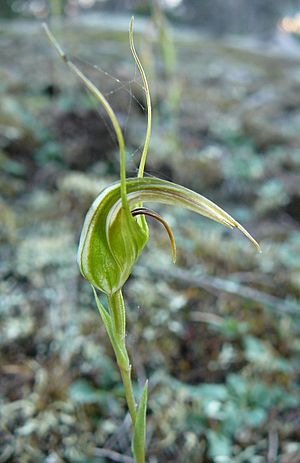Curved greenhood facts for kids
Quick facts for kids Curved greenhood |
|
|---|---|
 |
|
| Pterostylis longipetala growing in Bournda National Park | |
| Scientific classification | |
| Genus: |
Pterostylis
|
| Species: |
longipetala
|
| Synonyms | |
|
Diplodium longipetalum (Rupp) D.L.Jones & M.A.Clem. |
|
The curved greenhood (scientific name: Pterostylis longipetala) is a special type of orchid. It is found only in eastern Australia. This means it is endemic to that area.
Like other greenhood orchids, the plant looks different depending on if it is flowering or not. Plants that are not flowering have a group of leaves shaped like a circle, lying flat on the ground. But when the plant flowers, it grows a single flower on a tall stem. This stem also has leaves. The curved greenhood has flowers that are dark green, brown, and white. They lean a little bit forward. The flowers have sharp, pointed petals and a long, curved part called a labellum.
Contents
What Does the Curved Greenhood Look Like?
The curved greenhood is a plant that grows from an underground tuber (like a small potato). It is a perennial plant, meaning it lives for more than two years. It is also a deciduous plant, which means some parts die back each year.
Leaves of the Curved Greenhood
When the plant is not flowering, it has a group of three to six dark green, egg-shaped leaves. These leaves lie flat on the ground. Each leaf is about 8 to 15 millimeters (0.3 to 0.6 inches) long. They are also about 4 to 10 millimeters (0.16 to 0.4 inches) wide.
Flowers of the Curved Greenhood
Flowering plants grow a single flower on a stem. This stem is usually 100 to 160 millimeters (4 to 6 inches) tall. It has three to five leaves along its length. The flower itself is about 14 to 17 millimeters (0.55 to 0.67 inches) long. It is also about 4 to 8 millimeters (0.16 to 0.3 inches) wide. The flowers are dark green, brown, and white. They lean slightly forward.
Parts of the Flower
The top part of the flower, called the dorsal sepal, joins with the petals. Together, they form a hood over the central part of the flower, which is called the column. The dorsal sepal has a thin, thread-like tip. This tip is about 6 to 12 millimeters (0.24 to 0.47 inches) long. The petals also have pointed tips.
The lateral sepals are the two side parts of the flower. They stand upright and stay close to the hood. They have long, thread-like tips that are about 20 to 25 millimeters (0.79 to 0.98 inches) long. There is a V-shaped gap, called a sinus, between the bases of these sepals.
The labellum is a special part of the orchid flower. For the curved greenhood, it is about 12 to 15 millimeters (0.47 to 0.59 inches) long. It is about 3 millimeters (0.12 inches) wide. This labellum is dark reddish-brown and curved. It sticks out above the V-shaped sinus.
When Does it Flower?
The curved greenhood usually flowers from April to June.
How the Curved Greenhood Got its Name
Every plant has a scientific name, which helps scientists around the world know exactly which plant they are talking about. This system of naming is called taxonomy.
First Description
The curved greenhood, Pterostylis longipetala, was first officially described in 1943. A scientist named Herman Rupp wrote about it. He found a sample of the plant near Batemans Bay in Australia. His description was published in a scientific paper called Proceedings of the Linnean Society of New South Wales.
Meaning of the Name
The second part of the scientific name, longipetala, comes from two Latin words. Longus means "long," and petalum means "petal." So, longipetala means "long petals."
Herman Rupp did not say why he chose this name. However, he did mention that the petals of this orchid were "narrower and longer than in any other species of Pterostylis known to me." This suggests the long petals were a key feature he noticed.
Where the Curved Greenhood Lives
The curved greenhood grows in New South Wales, Australia. You can find it on moist slopes in forests near the coast. It likes places that are a bit damp.

